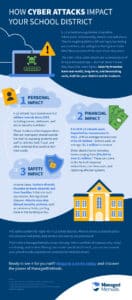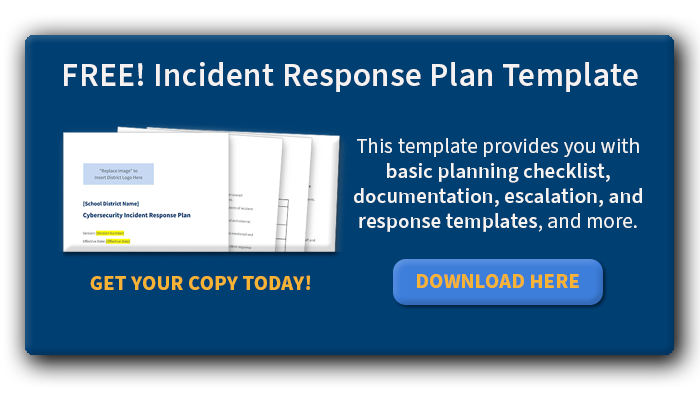According to the White House, the United States has experienced an increase in cyber attacks targeting the nation’s K-12 school system. In fact, in the 2022-23 academic year alone, at least eight districts across the country fell victim to cyber threats — half of which forced schools to cancel classes or close completely.
Indeed, if you’re not careful, a successful cyber attack could prove devastating. However, there’s much more at stake than a temporary disruption. With loads of sensitive information up for grabs, even a single security breach could have long-term and far-reaching consequences for students and staff members alike.
Read on to find out more about K-12 cyber attacks, including what you can do to protect your students and their personal information from unauthorized access and exposure.
Understanding cyber attacks
A cyber attack is any type of malicious activity that attempts to collect, disrupt, deny, degrade, or destroy computer system resources or information itself. Threat actors — such as hackers or cyber criminals — normally attack organizations with a particular goal in mind, like stealing personal data or disturbing regular business activities.

When hackers successfully get their hands on sensitive data, this type of cyber incident is known as a data breach. Of course, most organizations have security measures in place to stop threat actors in their tracks before they gain unauthorized access to sensitive information.
However, as cybersecurity advances, cyber criminals grow more sophisticated to match. That’s why businesses — school districts included — must continuously strengthen their threat protection strategies. Otherwise, they’re sure to fall victim to any number of increasingly dangerous attack vectors.
For instance, here are some of the most common types of cyber threats impacting K-12 school districts:
- Malware: Short for “malicious software,” malware is what many people call a “virus.” There are many variants floating through cyberspace, each designed to exploit various computer system vulnerabilities. Generally, a malware attack aims to infect information systems with software or malicious code, which spreads and gradually harvests personal data.
- Ransomware: As a particular form of malware, ransomware takes the exact same attack strategy. However, once hackers steal the information, they demand a lofty ransom payment in exchange for returning the data unharmed or exposed. Roughly 80% of K-12 schools are impacted by ransomware attacks, with an average payment of $1.2 million.
- Social engineering: A social engineering tactic, such as a phishing attack, aims to fool unsuspecting people into revealing personal information or granting access to hackers under the guise of something legitimate. For instance, a threat actor might pretend to be a school administrator to convince a student to share their login credentials.
- DDoS attack: A distributed denial-of-service (DDoS) attack attempts to disrupt the normal traffic of a targeted resource, like a website or server, to take it offline. In short, hackers overwhelm the target with a flood of fake internet traffic.
- Account takeovers: Although often considered its own threat vector, an account takeover can really encompass many types of cyber attacks. As the name suggests, this particular cyber risk aims to gain unauthorized access to user accounts, thereby allowing them to manipulate privileged information. For instance, if a hacker cracks into a student’s OneDrive account, they’ll be able to exfiltrate any resource they have access to.
![[FREE] K-12 CYBERSECURITY INCIDENT RESPONSE PLAN TEMPLATE >> Get Your Copy Today!](https://no-cache.hubspot.com/cta/default/6834707/f6b7b66c-dbb3-403a-b179-2ecd31e0e893.png)
Why do cyber criminals attack schools?
K-12 school districts are prime targets for cyber threats. In fact, a recent report reveals that education organizations in the United States are experiencing a “massive spike” in malware, encrypted threats, and cryptojacking in 2023.
Moreover, malware attacks rose 466% between January and June compared to the same period in 2022. Worse yet, there’s been an eye-opening leap —- 2,580% — in malware delivered over encrypted means. Overall, education is the second most targeted industry so far this year.
Why? Think about it: Your district has a ton of sensitive information. From Social Security numbers and personal data to home addresses and more, you’re storing a goldmine of valuable data. Hackers consider this type of information lucrative, as they can easily flip it on the dark web for a big payday. Plus, given the nature of the data, they can leverage it against school districts for a hefty ransom.
Unfortunately, schools are also not the most sophisticated in terms of cybersecurity — especially in the cloud. Although over 90% of districts use either Google Workspace or Microsoft 365, fewer than 20% of budgets include security measures for cloud-based threats. To make matters worse, many lack full-time cybersecurity staff or cyber risk management training.
Cyber attack impacts: What’s at stake for your school district?
You might not realize it, but there’s a lot on the line when it comes to school cybersecurity. Let’s review the most significant consequences to better understand how a data breach could impact your district:
1. Financial impact
Although the cost of cyber crime can vary depending on the industry, its price tag is rarely affordable. Globally, the average cost of a data breach is $4.45 million per incident. In the United States, that number more than doubles.
Cyber attacks may incur a smaller financial toll on school districts, but the cost is still exorbitant given how tight school budgets can be. According to a Government Accountability Office (GAO) report, monetary losses stemming from K-12 cyber crime can range between $50,000 to over $1 million. These knock-on costs can include rising insurance deductibles, additional overtime pay, and system recovery. If a cyber incident is severe enough, it may even require you to replace the affected resources.
2. Personal impact
According to a 2023 study, K-12 schools have leaked over 5.3 million records since 2005. When someone’s personal information, such as a physical address or phone number, is either leaked or stolen online, it creates a very serious problem for the victims. In some cases, a single cyber incident could have long-term repercussions.
For example, it’s exceedingly common for underage children to fall victim to identity theft. If a threat actor gains access to a cache of personal data, they may sell the information to the highest bidder. Normally, the buyer leverages this information to make fraudulent charges in the child’s name, ruining their credit for years to come. Worse yet, most victims don’t realize their identity has been stolen until several years later.
3. Safety impact
Worst of all, cyber attacks can have far-reaching consequences that quite literally hit close to home. Sometimes, hackers even threaten to harm students and staff if their districts don’t comply with their demands.
An early example of this happened in 2017 to a Montana school district that experienced a ransomware attack. A cyber crime gang called “The Dark Overlord Solution” threatened violence against students if the ransom wasn’t paid. The criminals even used stolen information to contact and harass students’ parents. Fortunately, no harm ever came to the students or their families.
Additional impacts
Aside from the financial, personal, and safety concerns associated with cybersecurity, you should also consider the following:
- Reputational damage: A cyber attack could embarrass your district and encourage families to take their children somewhere else.
- Educational disruption: According to the GAO, the average loss of learning after a data breach ranges between three days and three weeks.
- Compliance: State data privacy laws can be strict depending on your location. Failing to prevent an attack could expose the district to legal liabilities and fines.
![[FREE] K-12 CYBERSECURITY INCIDENT RESPONSE PLAN TEMPLATE >> Get Your Copy Today!](https://no-cache.hubspot.com/cta/default/6834707/f6b7b66c-dbb3-403a-b179-2ecd31e0e893.png)
Causes of school cyber attacks
It’s obvious that cyber attacks can lead to a lot of damage. But how do they happen in the first place? Here are some of the most common causes:
- Insider threats: Whether maliciously or not, insiders (e.g., students and staff) may leak sensitive data online. For example, many insider incidents happen because someone improperly shared a file with the wrong recipient. In 2023, St. Louis Park School District accidentally shared thousands of students’ personal data in an email.
- Vendors: Third-party vendors, such as cloud applications, software vendors, and managed service providers, have access to your data. In turn, they could jeopardize your security if their own defenses are vulnerable to attack.
- Unsanctioned apps: Students often download cloud applications they’re not authorized to use. This increases the risk of a data breach, as it stretches your attack surface even further.
- Malicious websites: Users may access websites designed to inject malware or malicious code into their browser, infecting the entire computer system.
How can schools protect themselves from cyber attacks?
Luckily, there’s plenty you can do to harden your defenses. Here are a few best practices to get started:
- Know your vulnerabilities: Audit your cloud domain to see where you may be defenseless or open to attack. Then, prioritize solutions that address these risk factors.
- Apply for grant programs: Schools with a limited cybersecurity budget can secure more funding by applying to state and federal grant programs.
- Create an incident response plan: Planning makes perfect. That’s why cybersecurity professionals advocate incident response planning, which can help prepare your district for an eventual cyber attack.
- Use a content filter: Schools are required by law to filter harmful content so that minors can’t access it online. However, an advanced filtering solution can also serve as a first line of defense by preventing anyone from navigating to malicious websites.
- Start cloud monitoring: A cloud monitoring tool can give you early warning of potential threats in Google Workspace or Microsoft 365. The sooner you identify risks, the faster you can intervene and mitigate them.
Mitigate cyber risk with ManagedMethods
It’s clear that K-12 has a cybersecurity problem. The good news? At ManagedMethods, we’ve developed two helpful solutions.
With Content Filter and Cloud Monitor, you not only can block harmful material, but also automate threat detection at scale. Regardless of the size of your team, our platform integrates seamlessly into Google Workspace and Microsoft 365 to rapidly identify risks and help you avoid a potential breach.
Prepare for cyber attacks and mitigate impacts by implementing an incident response plan. Download the incident response planning template today.

